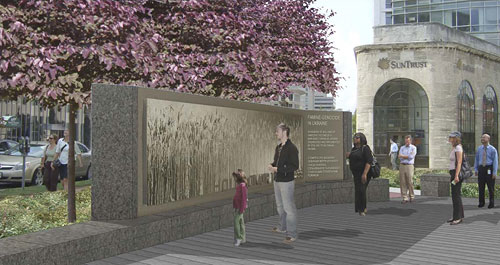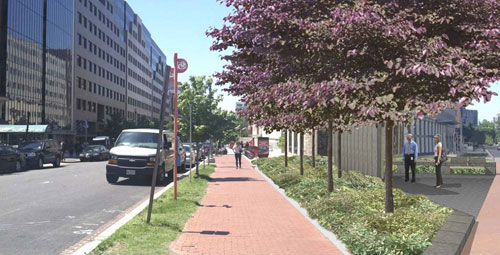Grassy triangle will become a plaza and Ukrainian memorial
A small, empty grass triangle just west of Union Station will soon be a new memorial. Victims of the Ukranian Manmade Famine of 1932-1933 will get memorialized, and residents and workers will get a usable plaza. The back side of the memorial, however, will turn a mostly blank wall to F Street.
The National Capital Planning Commission sees most empty triangles like this one as spots for future memorials, and Congress likes to authorize memorials, like this one. These spaces are also part of a city, whose people need spaces to sit outside, eat a snack, run around, and more.
Fortunately, the two don’t have to conflict. A number of memorials work well as public spaces at the same time. An oft-cited example is the Navy Memorial, at 8th and Pennsylvania, NW. It’s an attractive fountain which sports a mast with naval flags, quotations from famous commanders, a map of the world’s oceans, and more. Plus, it’s a great spot to sit outside on a nice day and eat lunch.
The National Law Enforcement Officers Memorial isn’t bad. Others do little; the memorials to Samuel Hahnemann (founder of homeopathy) and Daniel Webster (statesman and orator) in the triangles next to Scott Circle are just large statues in the midst of some grass and paths; their presence doesn’t create any usable public space. Some of the fears around the proposed Eisenhower Memorial involve design elements that could detract from people actually using the square.
The Ukranian famine memorial will sport a 6-foot bronze wall, with a bas-relief facing Massachusetts Avenue. In front of the wall will be a plaza, open to Mass. Ave. and with benches on 2 sides.
NCPC, DC historic preservation officials, and the Commission on Fine Arts all pushed the memorial designers to improve the way it backs onto F Street. The original submission lacked any design for the back of the wall along F, and tall cylindrical trees might have “create[d] a large vegetation wall that might overwhelm pedestrians.”
In response, the designers moved the wall farther from F Street, reducing its visual size from the sidewalk, added some texture to the back, and changed the trees to ones that will leave open space at eye level. It’s still not ideal; it’s still a blank wall with some ground cover in front, but it’s an improvement and the whole wall is not very large.
The whole design is definitely better for public space than the “Tear Drops on a Wheat Field” finalist design, which would have filled the whole site with tall vegetation and plopped some big glass bubbles in the center.
More memorials will keep coming. Congress has authorized an Adams Memorial to the two presidents and the rest of the Adams Family. NCPC, preservation boards, and residents can work to ensure that that memorial not only avoids being creepy, kooky, mysterious or spooky, but also serves to enhance the urban experience instead of detract as it also helps people remember.





